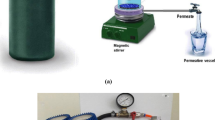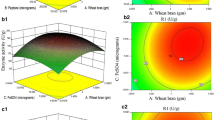Abstract
A response surface method was used to optimize the purification and concentration of gluconic acid from fermentation broth using an integrated membrane system. Gluconobacter oxydans was used for the bioconversion of the glucose in sugarcane juice to gluconic acid (concentration 45 g∙L–1) with a yield of 0.9 g∙g–1. The optimum operating conditions, such as trans-membrane pressure (TMP), pH, cross-flow rate (CFR) and initial gluconic acid concentration, were determined using response surface methodology. Five different types of polyamide nanofiltration membranes were screened and the best performing one was then used for downstream purification of gluconic acid in a flat sheet cross-flow membrane module. Under the optimum conditions (TMP = 12 bar and CFR = 400 L∙h–1), this membrane retained more than 85% of the unconverted glucose from the fermentation broth and had a gluconic acid permeation rate of 88% with a flux of 161 L∙m–2∙h–1. Using response surface methods to optimize this green nanofiltration process is an effective way of controlling the production of gluconic acid so that an efficient separation with high flux is obtained.

Similar content being viewed by others
References
Pal P, Kumar R, Nayak J, Banerjee S. Fermentative production of gluconic acid in membrane-integrated hybrid reactor system: Analysis of process intensification. Chemical Engineering & Processing, 2017, 122: 258–268
Ramachandran S, Fontanille P, Pandey A, Larroche C. Gluconic acid: Properties, applications and microbial production. Food Technology and Biotechnology, 2006, 44: 185–195
El-Enshasy H A. Production of gluconic acid by free and immobilized cells of recombinant Aspergillus niger in batch culture. Egyptian Journal of Biotechnology, 2003, 13: 187–201
Food Chemicals Codex. Seventh ed. Maryland: United Book Press Inc., 2010, 523
Deller K, Krause H, Peldszus E, Despeyroux B. US Patent, 5132452, 1992
Singh O V, Kumar R. Biotechnological production of gluconic acid: Future implications. Applied Microbiology and Biotechnology, 2007, 75(4): 713–722
Shang W, Wang D, Wang X. Modeling of the separation performance of nanofiltration membranes and its role in the applications of nanofiltration technology in product separation processes. Frontiers of Chemical Engineering in China, 2007, 1(2): 208–215
Pal P, Kumar R, Banerjee S. Manufacture of gluconic acid: A review towards process intensification for green production. Chemical Engineering & Processing, 2016, 104: 160–171
Rehr B, Wilhelm C, Sahm H. Production of sorbitol and gluconic acid by permeabilized cells of Zymomonas mobilis. Applied Microbiology and Biotechnology, 1991, 35(2): 144–148
Stephanopoulos G, Reklaitis G V. Process systems engineering: From Solvay to modern bio-and nanotechnology: A history of development, successes and prospects for the future. Chemical Engineering Science, 2011, 66(19): 4272–4306
Abels C, Carstensen F, Wessling M. Membrane processes in biorefinery applications. Journal of Membrane Science, 2013, 444: 285–317
Pal P, Dekonda V C, Kumar R. Fermentative production of glutamic acid from renewable carbon source: Process intensification through membrane-integrated hybrid bio-reactor system. Chemical Engineering & Processing, 2015, 92: 7–17
Dey P, Pal P. Direct production of L (+) lactic acid in a continuous and fully membrane-integrated hybrid reactor system under nonneutralizing conditions. Journal of Membrane Science, 2012, 389: 355–362
Morthensen S T, Zeuner B, Meyer A S, Jørgensen H, Pinelo M. Membrane separation of enzyme-converted biomass compounds: Recovery of xylose and production of gluconic acid as a valueadded product. Separation and Purification Technology, 2018, 194: 73–80
Panpae K, Jaturonrusmee W, Mingvanish W, Nuntiwattanawong C, Chunwiset S, Santudrob K, Triphanpitak S. Minimization of sucrose losses in sugar industry by pH and temperature optimization. Malaysian Journal of Analytical Sciences, 2008, 12: 513–519
Dey P, Linnanen L, Pal P. Separation of lactic acid from fermentation broth by cross flow nanofiltration: Membrane characterization and transport modelling. Desalination, 2012, 288: 47–57
Chakrabortty S, Roy M, Pal P. Removal of fluoride from contaminated groundwater by cross flow nanofiltration: Transport modeling and economic evaluation. Desalination, 2013, 313: 115–124
Boczek L A, Rice E W, Johnson C H. Total viable counts pour plate technique. In: Carl A B, Mary T, eds. Encyclopedia of Food Microbiology. 2nd ed. Cambridge: Academic Press, 2014, 625–629
Robinson J P, Tarleton E S, Millington C R, Nijmeijer A. Solvent flux through dense polymeric nanofiltration membranes. Journal of Membrane Science, 2004, 230(1-2): 29–37
Tanninen J, Manttari M, Nystrom M. Effect of salt mixture concentration on fractionation with NF membranes. Journal of Membrane Science, 2006, 283(1–2): 57–64
Xu G Q, Chu J,Wang Y, Zhuang Y, Zhang S, Peng H. Development of a continuous cell-recycle fermentation system for production of lactic acid by Lactobacillus paracasei. Process Biochemistry, 2006, 41(12): 2458–2463
Tsibranska I H, Tylkowski B. Concentration of ethanolic extracts from Sideritis ssp. L. by nanofiltration: Comparison of dead-end and cross-flow modes. Food and Bioproducts Processing, 2013, 91(2): 169–174
Balyan U, Sarkar B. Integrated membrane process for purification and concentration of aqueous Syzygium cumini (L.) seed extract. Food and Bioproducts Processing, 2016, 98: 29–43
Morthensen S T, Luo J, Meyer A S, Jørgensen H, Pinelo M. High performance separation of xylose and glucose by enzyme assisted nanofiltration. Journal of Membrane Science, 2015, 492: 107–115
Pal P, Chakrabortty S, Nayak J, Senapati S. A flux-enhancing forward osmosis-nanofiltration integrated treatment system for the tannery wastewater reclamation. Environmental Science and Pollution Research International, 2017, 24(18): 15768–15780
Werner A, Rieger A, Mosch M, Haseneder R, Repke J U. Nanofiltration of indium and germanium ions in aqueous solutions: Influence of pH and charge on retention and membrane flux. Separation and Purification Technology, 2018, 194: 319–328
Xu Y, Lebrun R E. Investigation of the solute separation by charged nanofiltration membrane: Effect of pH, ionic strength and solute type. Journal of Membrane Science, 1999, 158(1-2): 93–104
Choi J H, Fukushi K, Yamamoto K. A study on the removal of organic acids from wastewaters using nanofiltration membranes. Separation and Purification Technology, 2008, 59(1): 17–25
Mänttäri M, Pihlajamäki A, Nyström M. Effect of pH on hydrophilicity and charge and their effect on the filtration efficiency of NF membranes at different pH. Journal of Membrane Science, 2006, 280(1-2): 311–320
Xu L, Du L S, He J. Effects of operating conditions on membrane charge property and nanofiltration. Frontiers of Chemical Science and Engineering, 2011, 5(4): 492–499
Ma Z, Wang M, Gao X, Gao C. Charge and separation characteristics of nanofiltration membrane embracing dissociated functional groups. Frontiers of Environmental Science & Engineering, 2014, 8(5): 650–658
Srivastava P K, Kapoor M. Extracellular endo-mannanase from Bacillus sp. CFR1601: Economical production using response surface methodology and downstream processing using aqueous two phase system. Food and Bioproducts Processing, 2013, 91(4): 672–681
Sankpal N V, Kulkarni B D. Optimization of fermentation conditions for gluconic acid production using Aspergillus niger immobilized on cellulose microfibrils. Process Biochemistry, 2002, 37(12): 1343–1350
Bezerra M A, Santelli R E, Oliveira E P, Villar L S, Escaleira´ L A. Response surface methodology (RSM) as a tool for optimization in analytical chemistry. Talanta, 2008, 76(5): 965–977
Myers R H, Montgomery D C, Anderson-Cook C M. Response Surface Methodology: Process and Product Optimization Using Designed Experiments. 3rd ed. New Jersey: John Wiley & Sons publishers, 2009
Trinh T K, Kang L S. Response surface methodological approach to optimize the coagulation-flocculation process in drinking water treatment. Chemical Engineering Research & Design, 2011, 89(7): 1126–1135
Braghetta A, DiGiano F A, Ball W P. Nanofiltration of natural organic matter: pH and ionic strength effects. Journal of Environmental Engineering, 1997, 123(7): 628–641
Acknowledgements
The authors thank the Department of Science and Technology, Government of India (DST) for the grants under the DST-FIST Program and the University Grant Commission, Government of India for financial assistance under the Dr. D.S. Kothari Post-Doctoral Fellowship (No.F.4-2/2006 (BSR)/EN/16-17/0001).
Author information
Authors and Affiliations
Corresponding author
Rights and permissions
About this article
Cite this article
Pal, P., Kumar, R. & Banerjee, S. Purification and concentration of gluconic acid from an integrated fermentation and membrane process using response surface optimized conditions. Front. Chem. Sci. Eng. 13, 152–163 (2019). https://doi.org/10.1007/s11705-018-1721-z
Received:
Accepted:
Published:
Issue Date:
DOI: https://doi.org/10.1007/s11705-018-1721-z




